Learn Drawing with this comprehensive guide tailored for beginners to advanced artists, brought to you by LEARNS.EDU.VN. Unleash your creative potential and master the art of sketching, illustration, and visual expression through accessible techniques and expert insights. Explore art fundamentals to sketching essentials today.
1. Understanding the Fundamentals of Learn Drawing
Learn drawing involves more than just putting pencil to paper; it’s about understanding fundamental principles that underpin all visual art forms. Grasping these basics allows you to translate your observations and imagination onto the canvas effectively.
1.1. Essential Elements of Art
The elements of art are the basic building blocks artists use to create a work of art. These include:
- Line: A mark made on a surface that can vary in width, length, direction, and curvature. Lines are used to define shapes, create contours, suggest movement, and convey emotions.
- Shape: A two-dimensional area with a recognizable boundary. Shapes can be geometric (e.g., circles, squares, triangles) or organic (free-form and irregular).
- Form: A three-dimensional object with height, width, and depth. Forms can be real (sculptures) or implied (rendered through shading and perspective in drawings).
- Value: The lightness or darkness of a color or tone. Value is crucial for creating contrast, depth, and the illusion of light and shadow.
- Color: The visual perception that results from the way the human eye and brain interpret the spectrum of light. Color has three main properties: hue (the name of the color), saturation (the intensity of the color), and value (the lightness or darkness of the color).
- Texture: The surface quality of an object, either real (tactile texture) or implied (visual texture). Texture can be rough, smooth, bumpy, soft, etc., and adds richness and interest to artwork.
- Space: The area around and within objects in a composition. Space can be positive (occupied by objects) or negative (empty areas). Artists use space to create depth, balance, and visual interest.
Understanding how these elements interact is essential for creating compelling and visually appealing drawings.
1.2. The Importance of Perspective in Learn Drawing
Perspective is the technique used to represent three-dimensional objects on a two-dimensional surface in a way that creates a sense of depth and spatial relationships. Mastering perspective is crucial for achieving realism and accuracy in your drawings.
Types of Perspective:
| Type of Perspective | Description | Application |
|---|---|---|
| One-Point Perspective | All parallel lines converge at a single vanishing point on the horizon line. | Ideal for drawing roads, hallways, and any scene where you’re looking straight ahead. |
| Two-Point Perspective | Parallel lines converge at two vanishing points on the horizon line. | Commonly used for drawing buildings, street scenes, and objects viewed from an angle. |
| Three-Point Perspective | Parallel lines converge at three vanishing points (two on the horizon line and one either above or below). | Used for dramatic, exaggerated views of objects or scenes, such as looking up at a tall building (worm’s-eye view) or down from a great height (bird’s-eye view). |
| Atmospheric Perspective | Creating the illusion of depth by simulating the effects of the atmosphere on objects as they recede into the distance. Objects appear less detailed, lighter in value, and cooler in color as they move further away. | Used to create a sense of depth and realism in landscapes, cityscapes, and other scenes where distance is a significant factor. |
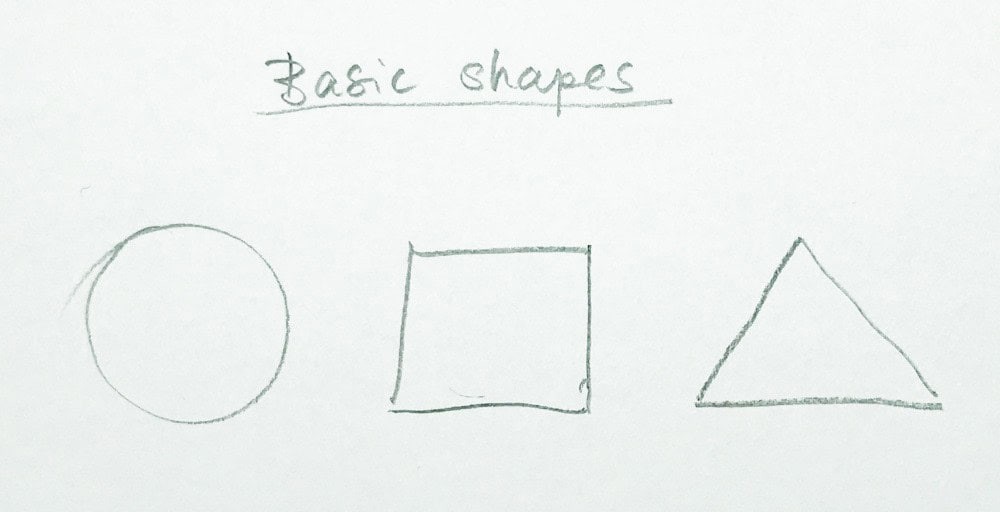
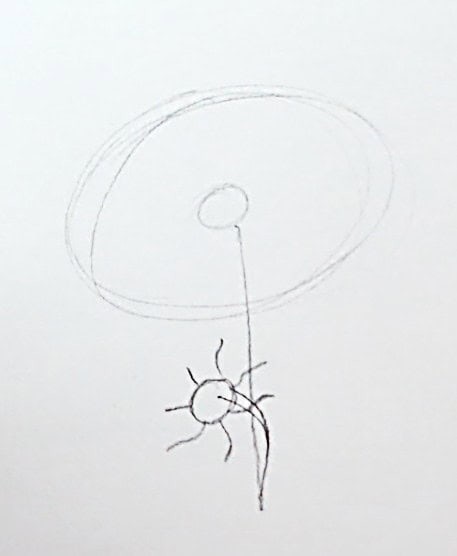
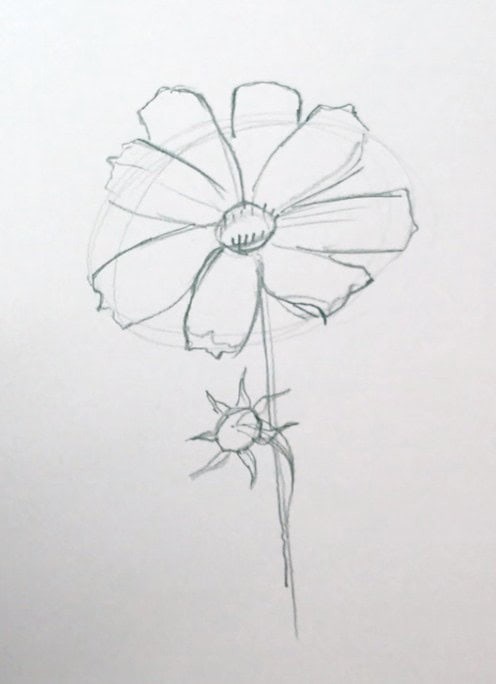
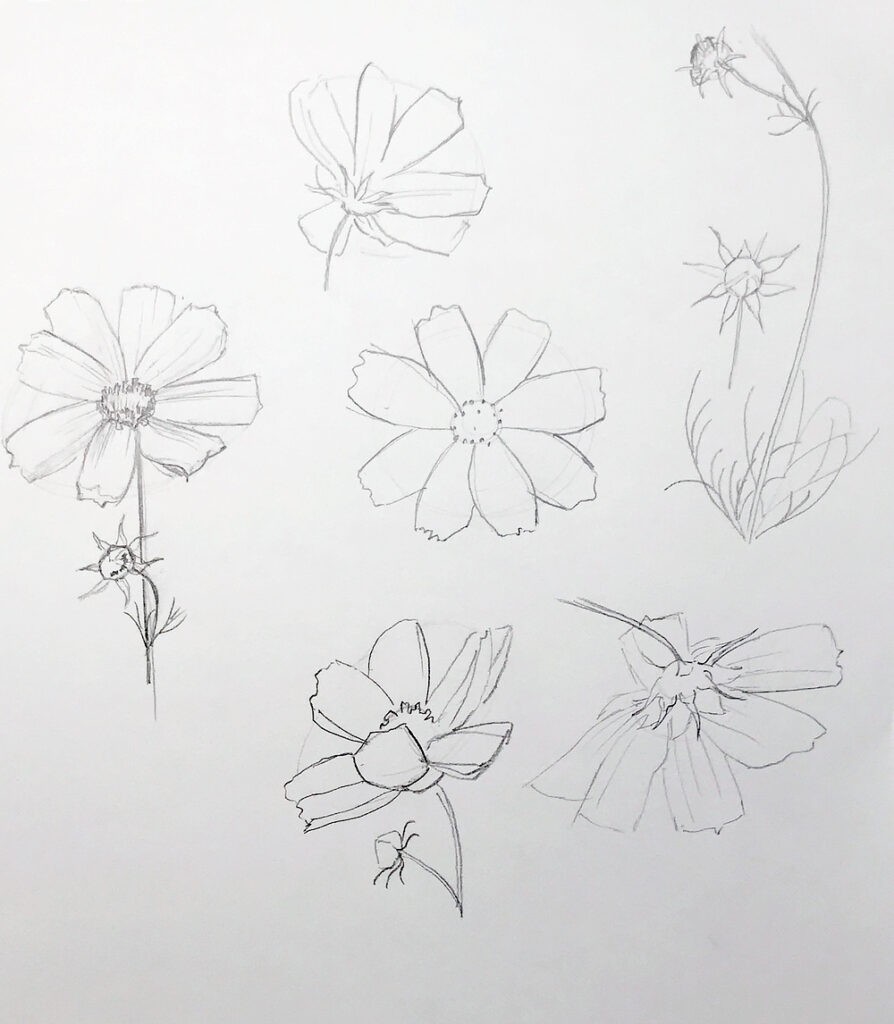
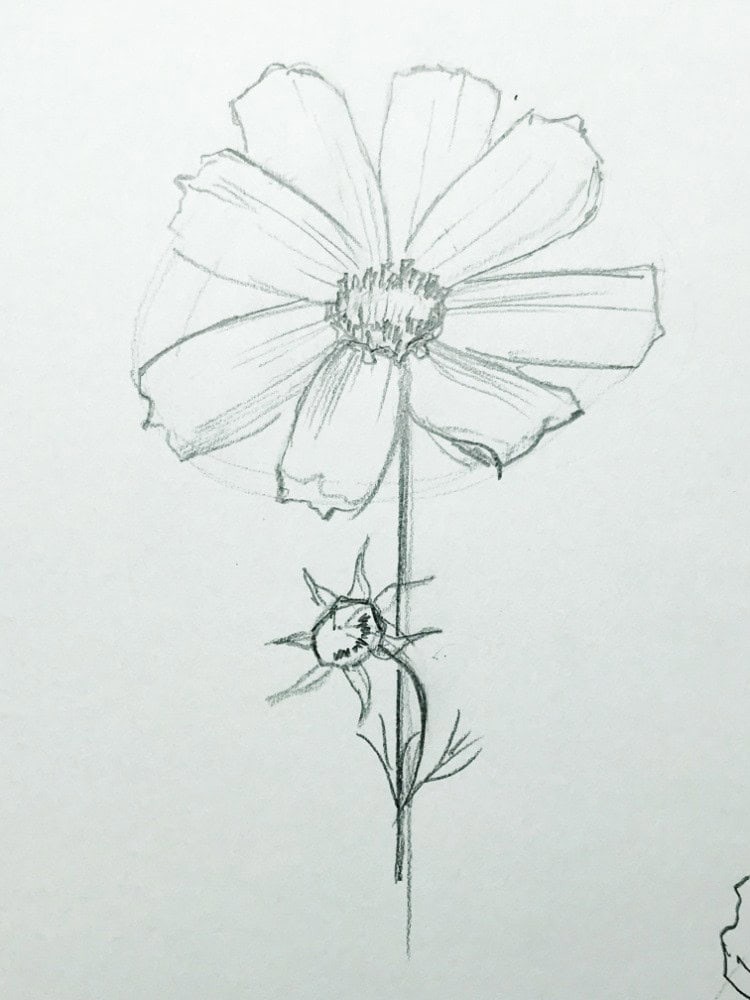
1.3. Value and Shading: Creating Depth in Learn Drawing
Value refers to the lightness or darkness of a color or tone. Shading is the technique of using value to create the illusion of form, depth, and light in a drawing. Understanding value and shading is essential for making your drawings look three-dimensional and realistic.
Key Concepts in Value and Shading:
- Light Source: The direction from which light is hitting the object. This determines the placement of highlights and shadows.
- Highlights: The lightest areas on the object, where the light is hitting most directly.
- Shadows: The darker areas on the object, where the light is blocked.
- Core Shadow: The darkest part of the shadow, located on the side of the object opposite the light source.
- Reflected Light: Light that bounces off surrounding surfaces and illuminates the shadow area, making it slightly lighter than the core shadow.
- Cast Shadow: The shadow that the object casts onto the surrounding surface.
Shading Techniques:
| Technique | Description | Best Used For |
|---|---|---|
| Hatching | Creating value by drawing a series of parallel lines. The closer the lines, the darker the value. | Quick sketches, textures, and suggesting form. |
| Cross-Hatching | Creating value by drawing two or more layers of hatching lines that intersect each other. | Creating deeper values and more complex textures. |
| Stippling | Creating value by making a pattern of dots. The closer the dots, the darker the value. | Textures, subtle gradients, and detailed areas. |
| Blending | Smoothing out values by using a blending stump, tortillon, or your finger to smudge the graphite or charcoal. | Smooth surfaces, soft transitions, and creating a sense of realism. |
| Rendering | A combination of different shading techniques to create a highly detailed and realistic depiction of form and light. | Complex subjects, portraits, and creating a polished look. |
Understanding these fundamentals is the cornerstone of learn drawing. As you practice and refine these skills, you’ll develop a solid foundation for creating impressive artwork. For more in-depth tutorials and guidance, visit LEARNS.EDU.VN, where you can discover a wealth of resources to elevate your artistic journey.
2. Essential Drawing Tools and Materials
Having the right tools and materials can significantly enhance your learn drawing experience. Here’s a breakdown of essential supplies to help you get started and advance your skills.
2.1. Pencils: Graphite, Charcoal, and Colored
Pencils are the cornerstone of learn drawing, offering versatility and control for creating a wide range of effects. Understanding the different types of pencils and their properties is essential for achieving desired results.
| Pencil Type | Description | Best Uses |
|---|---|---|
| Graphite Pencils | Made from a mixture of graphite and clay, graphite pencils come in a range of hardnesses, typically labeled from 9H (hardest) to 9B (softest). Harder pencils (H grades) produce lighter, finer lines, while softer pencils (B grades) create darker, broader lines. | Sketching, outlining, shading, and creating detailed drawings. The range of hardnesses allows for versatility in achieving different values and effects. |
| Charcoal Pencils | Made from compressed charcoal, these pencils offer rich, dark values and a wide range of tonal possibilities. Charcoal pencils are available in varying degrees of hardness, from soft and smudgy to hard and precise. | Creating dramatic shadows, bold lines, and expressive textures. Charcoal is ideal for achieving high contrast and a sense of depth in drawings. |
| Colored Pencils | Made from pigments mixed with a binder, colored pencils come in a vast array of colors and can be used for a variety of drawing techniques. Wax-based colored pencils are smooth and blendable, while watercolor pencils can be activated with water to create watercolor effects. | Adding color to drawings, creating vibrant illustrations, and achieving unique textures and effects. Colored pencils are versatile and can be used for both detailed work and broad areas of color. |
2.2. Paper: Choosing the Right Surface
The type of paper you use can significantly impact the outcome of your learn drawing. Different papers have different textures, weights, and absorbency levels, which can affect how your pencils, charcoal, or other drawing media behave.
| Paper Type | Description | Best Uses |
|---|---|---|
| Sketch Paper | Lightweight, inexpensive paper with a slightly textured surface. Sketch paper is ideal for practicing, quick sketches, and preliminary drawings. | Practicing basic techniques, experimenting with different compositions, and creating rough drafts of your ideas. Sketch paper is not suitable for detailed or finished drawings due to its thinness and tendency to bleed. |
| Drawing Paper | Medium-weight paper with a smoother surface than sketch paper. Drawing paper is more durable and can withstand erasing and layering. | Creating finished drawings with graphite, charcoal, or colored pencils. Drawing paper is suitable for a wide range of techniques and styles, from realistic renderings to expressive sketches. |
| Bristol Board | Heavyweight paper with a smooth, hard surface. Bristol board is available in two finishes: smooth (vellum) and plate (ultra-smooth). | Creating detailed, precise drawings with fine lines and smooth shading. Bristol board is ideal for pen and ink, graphite, and colored pencil work, and is often used for illustrations, comics, and technical drawings. |
| Watercolor Paper | Heavyweight paper designed to withstand the application of water-based media. Watercolor paper is available in three textures: rough, cold-pressed (medium texture), and hot-pressed (smooth texture). | Creating watercolor paintings, mixed media artwork, and drawings with watercolor pencils or inks. Watercolor paper is absorbent and durable, and can withstand multiple layers of washes without buckling or tearing. |
2.3. Other Essential Drawing Tools
In addition to pencils and paper, there are several other essential tools that can enhance your learn drawing experience.
| Tool | Description | Best Uses |
|---|---|---|
| Erasers | Kneaded erasers are soft, pliable erasers that can be molded into different shapes to erase small areas or create highlights. Vinyl erasers are hard, white erasers that are effective for removing graphite or charcoal completely. | Correcting mistakes, creating highlights, and lifting graphite or charcoal from the paper. Different erasers are suited for different tasks and media. |
| Blending Stumps | Tightly rolled paper tools used to blend graphite, charcoal, or pastel. Blending stumps are available in different sizes and shapes, and can be used to create smooth transitions and soft values. | Blending values, creating smooth gradients, and softening edges. Blending stumps are essential for achieving a polished, realistic look in drawings. |
| Sharpeners | Pencil sharpeners are used to maintain a sharp point on your pencils. Handheld sharpeners are portable and convenient, while electric sharpeners provide a more consistent and precise point. | Maintaining a sharp point on your pencils for creating fine lines and details. A sharp pencil is essential for precise drawing and achieving desired effects. |
| Rulers and Set Squares | Rulers and set squares are used to draw straight lines and accurate angles. These tools are essential for technical drawings, architectural renderings, and any drawing that requires precision. | Drawing straight lines, measuring distances, and creating accurate angles. Rulers and set squares are essential for technical drawings and any drawing that requires precision. |
Investing in quality drawing tools and materials can make a significant difference in your learn drawing journey. Experiment with different types of pencils, papers, and tools to find what works best for you and your style. For expert recommendations and reviews, visit LEARNS.EDU.VN, where you can find a curated selection of drawing supplies to help you unleash your creative potential.
3. Step-by-Step Drawing Techniques for Beginners
Learn drawing can seem daunting at first, but breaking down the process into manageable steps can make it more accessible and enjoyable. Here’s a step-by-step guide to help beginners develop essential drawing skills.
3.1. Basic Shapes and Forms
Start by mastering basic shapes and forms, such as circles, squares, triangles, cubes, spheres, and cylinders. These shapes are the building blocks of all complex objects, and learning to draw them accurately is essential for creating realistic drawings.
Exercises:
- Circles: Practice drawing circles freehand, focusing on creating smooth, continuous lines. Try varying the size and speed of your strokes to develop control and accuracy.
- Squares: Draw squares using a ruler or freehand, paying attention to creating straight lines and right angles. Practice drawing squares in different orientations to improve your spatial awareness.
- Triangles: Draw triangles of various sizes and shapes, focusing on creating sharp, precise angles. Experiment with different types of triangles, such as equilateral, isosceles, and scalene.
- Cubes: Combine squares to create cubes, paying attention to perspective and proportion. Practice drawing cubes from different angles to understand how they appear in three-dimensional space.
- Spheres: Shade circles to create the illusion of spheres, using smooth gradients to represent the curvature of the surface. Pay attention to the placement of highlights and shadows to create a sense of volume.
- Cylinders: Combine circles and straight lines to create cylinders, paying attention to perspective and proportion. Practice drawing cylinders from different angles to understand how they appear in three-dimensional space.
3.2. Line Drawing and Contour
Line drawing involves using lines to define the edges and contours of objects. Contour drawing focuses on capturing the outline of an object without lifting your pencil from the paper, helping you to develop your hand-eye coordination and observational skills.
Exercises:
- Blind Contour Drawing: Choose a simple object and draw its outline without looking at your paper. Focus on carefully observing the contours of the object and translating them onto the page.
- Modified Contour Drawing: Similar to blind contour drawing, but allow yourself to glance at your paper occasionally to check your progress and make corrections.
- Gesture Drawing: Capture the essence of a subject quickly and spontaneously, focusing on its overall form and movement. Use loose, gestural lines to convey the energy and dynamism of the subject.
3.3. Shading and Value
Shading and value are essential for creating the illusion of form, depth, and light in your drawings. Practice different shading techniques, such as hatching, cross-hatching, stippling, and blending, to create a range of values and effects.
Exercises:
- Value Scales: Create a value scale by drawing a series of boxes and filling them in with different values, from light to dark. Practice creating smooth transitions between values using different shading techniques.
- Spherical Shading: Shade a circle to create the illusion of a sphere, paying attention to the placement of highlights and shadows. Use smooth gradients to represent the curvature of the surface and create a sense of volume.
- Object Shading: Choose a simple object and shade it using different techniques to create a realistic depiction of its form and texture. Pay attention to the direction of the light source and the placement of highlights and shadows.
By practicing these step-by-step techniques, beginners can develop a solid foundation in drawing and gradually improve their skills. For more detailed tutorials and exercises, visit LEARNS.EDU.VN, where you can find a wealth of resources to support your artistic journey.
4. Advanced Drawing Techniques
Once you have mastered the fundamentals of learn drawing, you can explore more advanced techniques to elevate your artwork and create more complex and compelling compositions.
4.1. Figure Drawing and Anatomy
Figure drawing involves drawing the human figure, either from life or from reference images. Understanding anatomy is essential for creating accurate and believable figure drawings.
Key Concepts:
- Proportion: The relative size and scale of different body parts.
- Gesture: The overall pose and movement of the figure.
- Anatomy: The structure of the human body, including bones, muscles, and joints.
- Balance: The distribution of weight and mass in the figure.
Exercises:
- Gesture Drawing: Practice quick gesture drawings of the human figure, focusing on capturing the overall pose and movement.
- Anatomical Studies: Study anatomical diagrams and reference images to learn the structure of the human body.
- Life Drawing: Attend life drawing sessions and draw from live models to improve your observational skills and understanding of anatomy.
4.2. Portrait Drawing: Capturing Likeness
Portrait drawing involves creating a likeness of a person’s face. This requires careful observation, attention to detail, and an understanding of facial anatomy and expression.
Key Concepts:
- Facial Proportions: The relative size and placement of facial features, such as the eyes, nose, mouth, and ears.
- Value and Shading: Using value to create the illusion of form and depth in the face.
- Expression: Capturing the person’s unique personality and emotions through their facial features.
Exercises:
- Facial Proportions: Practice drawing basic facial features, paying attention to their proportions and placement on the face.
- Value Studies: Create value studies of different facial features to understand how light and shadow create form.
- Portrait Drawing: Draw portraits from reference images or from life, focusing on capturing the person’s likeness and expression.
4.3. Composition and Design
Composition refers to the arrangement of elements within a work of art. A strong composition can enhance the visual impact of your drawing and guide the viewer’s eye through the image.
Key Concepts:
- Rule of Thirds: Dividing the canvas into thirds both horizontally and vertically, and placing key elements at the intersections of these lines.
- Leading Lines: Using lines to guide the viewer’s eye through the composition.
- Balance: Creating a sense of equilibrium in the composition, either symmetrical or asymmetrical.
- Contrast: Using differences in value, color, or texture to create visual interest and emphasis.
Exercises:
- Thumbnail Sketches: Create small, quick sketches of different compositions to explore various arrangements of elements.
- Compositional Studies: Analyze the compositions of master artworks to understand how artists use composition to create visual impact.
- Applying Composition: Apply compositional principles to your own drawings to create more engaging and dynamic images.
By exploring these advanced drawing techniques, you can take your artwork to the next level and create more sophisticated and expressive drawings. For in-depth courses and personalized feedback, visit LEARNS.EDU.VN, where you can connect with experienced instructors and fellow artists.
5. Tips for Practicing Learn Drawing Effectively
Practicing is essential for improving your learn drawing skills. However, not all practice is created equal. Here are some tips for practicing effectively and making the most of your time.
5.1. Setting Realistic Goals
Set realistic goals for your learn drawing practice. Don’t try to learn everything at once. Instead, focus on mastering one skill or technique at a time.
Examples:
- Beginner: “I will practice drawing basic shapes and forms for 30 minutes each day.”
- Intermediate: “I will complete a figure drawing study each week, focusing on anatomical accuracy.”
- Advanced: “I will create a finished portrait drawing each month, exploring different compositional and lighting techniques.”
5.2. Regular Practice Schedule
Establish a regular practice schedule and stick to it as much as possible. Consistency is key to improving your skills and building momentum.
Tips:
- Schedule: Schedule specific times for drawing in your calendar and treat them like important appointments.
- Reminders: Set reminders on your phone or computer to help you stay on track.
- Habit Stacking: Combine your drawing practice with other habits, such as listening to a podcast or drinking your morning coffee.
5.3. Seeking Feedback and Critique
Seek feedback and critique from other artists, instructors, or online communities. Constructive criticism can help you identify areas for improvement and gain new perspectives on your work.
Ways to Get Feedback:
- Online Forums: Share your drawings on online art forums and ask for feedback from other members.
- Art Classes: Take art classes or workshops and receive feedback from instructors and classmates.
- Critique Groups: Join a local critique group and share your work with other artists in person.
By following these tips, you can create a more effective and enjoyable learn drawing practice that will help you achieve your artistic goals. For personalized guidance and support, visit LEARNS.EDU.VN, where you can access expert advice and connect with a community of passionate artists.
6. Overcoming Common Challenges in Learn Drawing
Learn drawing can be challenging, and it’s common to encounter obstacles along the way. Here are some common challenges and strategies for overcoming them.
6.1. Dealing with Frustration and Discouragement
It’s normal to feel frustrated or discouraged when your drawings don’t turn out the way you expect. Don’t let these feelings derail your progress.
Strategies:
- Focus on Progress: Instead of focusing on your mistakes, focus on the progress you’ve made and the skills you’ve learned.
- Take Breaks: If you’re feeling overwhelmed, take a break and come back to your drawing later with fresh eyes.
- Seek Inspiration: Look at the work of other artists for inspiration and motivation.
6.2. Avoiding Perfectionism
Perfectionism can be a major obstacle to creativity and progress. Don’t let the fear of making mistakes prevent you from experimenting and taking risks.
Strategies:
- Embrace Mistakes: View mistakes as learning opportunities and don’t be afraid to make them.
- Focus on Process: Focus on the process of drawing rather than the end result.
- Set Time Limits: Set time limits for your drawings to prevent yourself from overworking them.
6.3. Staying Motivated
Staying motivated can be challenging, especially when you’re not seeing immediate results. Find ways to keep yourself engaged and excited about drawing.
Strategies:
- Set Goals: Set achievable goals and reward yourself when you reach them.
- Join a Community: Connect with other artists and share your work and experiences.
- Experiment: Try new techniques and styles to keep your drawing practice fresh and interesting.
By recognizing and addressing these common challenges, you can overcome obstacles and continue to grow as an artist. For ongoing support and encouragement, visit LEARNS.EDU.VN, where you can find a supportive community and a wealth of resources to help you succeed.
7. Learn Drawing Online: Resources and Platforms
In today’s digital age, there are numerous online resources and platforms available to help you learn drawing from the comfort of your own home. Here are some of the best options.
7.1. Online Courses and Tutorials
Online courses and tutorials offer structured learning experiences that can guide you through the fundamentals and advanced techniques of learn drawing.
Popular Platforms:
- LEARNS.EDU.VN: Offers a wide range of drawing courses and tutorials for all skill levels, with expert instructors and personalized feedback.
- Skillshare: Features a variety of drawing classes taught by professional artists, covering topics such as figure drawing, portrait drawing, and illustration.
- Coursera: Partners with universities and institutions to offer online drawing courses that provide a more academic and structured learning experience.
7.2. YouTube Channels
YouTube is a treasure trove of free drawing tutorials and demonstrations. Many talented artists share their knowledge and expertise on the platform.
Recommended Channels:
- Proko: Features comprehensive anatomy and figure drawing tutorials taught by professional artist Stan Prokopenko.
- Draw with Jazza: Offers fun and engaging drawing tutorials for all skill levels, covering a wide range of topics and styles.
- SchaeferArt: Provides in-depth tutorials on drawing techniques, materials, and concepts, with a focus on realism and detail.
7.3. Online Communities and Forums
Online communities and forums provide opportunities to connect with other artists, share your work, and receive feedback.
Popular Communities:
- DeviantArt: A large online community for artists of all types, where you can share your work, receive feedback, and connect with other artists.
- ArtStation: A professional platform for artists in the game, film, and entertainment industries, where you can showcase your work and network with other professionals.
- Reddit Art Communities: Reddit hosts a variety of art-related communities, such as r/Art, r/learnart, and r/drawing, where you can share your work, ask questions, and receive feedback.
By leveraging these online resources and platforms, you can access a wealth of knowledge and support to help you learn drawing effectively. For a curated selection of the best online drawing resources, visit LEARNS.EDU.VN, where you can find everything you need to take your artistic skills to the next level.
8. The Benefits of Learn Drawing: Beyond Artistic Skills
Learn drawing offers a wide range of benefits that extend beyond artistic skills. Engaging in drawing can improve your cognitive abilities, emotional well-being, and overall quality of life.
8.1. Enhancing Creativity and Problem-Solving
Learn drawing encourages you to think creatively and explore new ideas. It also helps you develop problem-solving skills as you learn to overcome challenges and find innovative solutions.
Examples:
- Brainstorming: Drawing can be a powerful tool for brainstorming and generating new ideas.
- Visualizing: Drawing helps you visualize complex concepts and relationships, making them easier to understand.
- Experimenting: Drawing encourages you to experiment with different techniques and approaches, fostering creativity and innovation.
8.2. Improving Observation and Attention to Detail
Learn drawing requires careful observation and attention to detail. As you learn to draw, you’ll become more aware of the subtle nuances of the world around you.
Examples:
- Seeing Shapes: Drawing helps you see the underlying shapes and forms of objects, making it easier to represent them accurately.
- Noticing Details: Drawing encourages you to notice the small details that others might miss, such as textures, patterns, and subtle variations in light and shadow.
- Understanding Perspective: Drawing helps you understand the principles of perspective, allowing you to create realistic and believable depictions of three-dimensional space.
8.3. Reducing Stress and Promoting Mindfulness
Learn drawing can be a relaxing and meditative activity that helps reduce stress and promote mindfulness. Engaging in drawing allows you to focus on the present moment and escape from the worries and distractions of everyday life.
Examples:
- Mindful Focus: Drawing requires you to focus your attention on the task at hand, which can help calm your mind and reduce stress.
- Creative Expression: Drawing provides an outlet for creative expression, allowing you to communicate your thoughts and feelings in a non-verbal way.
- Relaxation: The repetitive and rhythmic motions of drawing can be soothing and relaxing, helping you unwind and de-stress.
By embracing the benefits of learn drawing, you can enrich your life in many ways beyond artistic expression. For guidance and resources to support your artistic journey, visit LEARNS.EDU.VN, where you can discover the transformative power of art.
9. Learn Drawing: Inspiring Examples and Case Studies
Exploring the works of master artists and contemporary illustrators can provide valuable insights and inspiration for your own learn drawing journey. Examining case studies of successful artists can reveal effective strategies and techniques for achieving artistic goals.
9.1. Master Artists and Their Techniques
Studying the techniques of renowned artists throughout history offers a rich understanding of artistic principles and methods.
Examples:
| Artist | Era | Key Techniques | Influence on Learn Drawing |
|---|---|---|---|
| Leonardo da Vinci | Renaissance | Masterful use of sfumato (subtle gradations of light and shadow), anatomical accuracy, and detailed observation of nature. | Emphasized the importance of studying anatomy, observing nature, and using subtle shading techniques to create realistic and expressive drawings. |
| Albrecht Dürer | Renaissance | Precise line work, intricate detail, and mastery of engraving and woodcut techniques. | Showcased the power of line drawing for creating detailed and expressive images and emphasized the importance of technical skill and precision. |
| Rembrandt van Rijn | Baroque | Dramatic use of light and shadow (chiaroscuro), expressive brushwork, and emotional depth. | Highlighted the importance of using light and shadow to create depth, drama, and emotional impact in drawings and emphasized the power of expressive mark-making. |
9.2. Contemporary Illustrators and Their Styles
Contemporary illustrators showcase diverse styles and techniques, reflecting modern trends and cultural influences.
Examples:
| Illustrator | Style | Key Techniques | Influence on Learn Drawing |
|---|---|---|---|
| Loish | Digital Illustration | Vibrant colors, dynamic compositions, and expressive character designs. | Demonstrated the possibilities of digital illustration and emphasized the importance of expressive character design and dynamic composition. |
| Jake Parker | Ink Drawing | Bold linework, imaginative concepts, and storytelling through visuals. | Inspired artists to explore the possibilities of ink drawing and storytelling through visuals and emphasized the importance of imagination and creativity. |
| James Jean | Mixed Media Illustration | Intricate patterns, surreal imagery, and blending of traditional and digital techniques. | Showcased the potential of mixed media illustration and inspired artists to experiment with different techniques and materials to create unique and imaginative artwork. |
9.3. Case Studies of Successful Artists
Examining the journeys of successful artists can provide valuable lessons and strategies for achieving your artistic goals.
Key Lessons:
- Persistence: Successful artists often face challenges and setbacks, but they persevere and continue to hone their skills.
- Experimentation: Artists who experiment with different techniques and styles are more likely to develop a unique voice and stand out from the crowd.
- Community: Building a supportive community of fellow artists can provide encouragement, feedback, and opportunities for collaboration.
By studying these inspiring examples and case studies, you can gain valuable insights and motivation for your own learn drawing journey. For additional resources and inspiration, visit LEARNS.EDU.VN, where you can explore a wealth of artwork and learn from experienced artists.
10. Learn Drawing: Frequently Asked Questions (FAQ)
Here are some frequently asked questions about learn drawing, with answers to help you on your artistic journey.
Q1: Is it possible to learn drawing if I have no natural talent?
A: Absolutely. Drawing is a skill that can be learned and developed through practice and dedication. While some people may have a natural aptitude for art, anyone can learn to draw with the right techniques and mindset.
Q2: What are the essential tools and materials for learn drawing?
A: Essential tools include graphite pencils (varying grades), erasers (kneaded and vinyl), drawing paper, sharpeners, and blending stumps. Additional tools may include charcoal pencils, colored pencils, rulers, and set squares.
Q3: How can I improve my drawing skills quickly?
A: Focus on practicing basic shapes and forms, line drawing, and shading techniques. Set realistic goals, establish a regular practice schedule, and seek feedback from other artists.
Q4: How do I overcome the fear of making mistakes in drawing?
A: Embrace mistakes as learning opportunities and don’t let them discourage you. Focus on the process of drawing rather than the end result, and remember that even master artists make mistakes.
Q5: What are some common challenges in learn drawing and how can I overcome them?
A: Common challenges include frustration, perfectionism, and lack of motivation. Strategies for overcoming these challenges include focusing on progress, taking breaks, seeking inspiration, and connecting with a supportive community.
Q6: Are there any online resources or platforms for learn drawing?
A: Yes, there are many online resources and platforms available, including online courses, YouTube channels, and online communities. Some popular platforms include LEARNS.EDU.VN, Skillshare, Coursera, and DeviantArt.
Q7: How can I stay motivated to continue learn drawing?
A: Set achievable goals, reward yourself when you reach them, connect with other artists, and experiment with new techniques and styles.
Q8: How can drawing benefit me beyond artistic skills?
A: Learn drawing can enhance creativity, problem-solving skills, observation skills, and attention to detail. It can also reduce stress and promote mindfulness.
Q9: What are some inspiring examples of master artists and their techniques?
A: Examples include Leonardo da Vinci (sfumato, anatomical accuracy), Albrecht Dürer (precise line work), and Rembrandt van Rijn (chiaroscuro, expressive brushwork).
Q10: How can I find a supportive community of artists to connect with?
A: Join online communities and forums, attend local art classes or workshops, and participate in critique groups. Websites like DeviantArt and Reddit host a variety of art-related communities.
Unlock your artistic potential today with LEARNS.EDU.VN. Visit us at 123 Education Way, Learnville, CA 90210, United States or contact us via Whatsapp at +1 555-555-1212. Explore our drawing courses and resources at learns.edu.vn and start your journey to artistic mastery! We hope to see you there.

